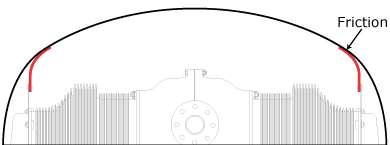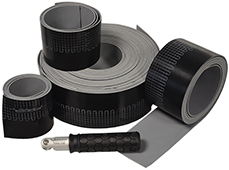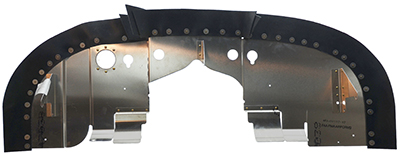Baffle Seal Material

30x less friction than any other baffle seal on earth!
Reduce airframe vibration, stop cowl and firewall cracks


Baffle seal friction causes airframe vibration and destroys cowls
Typical silicone rubber baffle seals have a coefficient of friction among the highest of any known material. This friction transfers engine vibration into your cowl and firewall causing

fastener fretting, fatigue, cracking, chafing and airframe vibration.
Cowl Saver™ has 30 times less friction!
- Dramatically reduces the friction between your cowl and baffle seals
- One side is silicone and the other is a low friction Teflon coated rubber
- Half of the engine vibration you feel in the cockpit is from baffle seal transfer
Low friction saves you money!
- Reduces transfer of vibration to the engine cowl and airframe
- Eliminates cowl erosion
- Extends baffle seal life
- Reduces expensive cowl and cowl fastener repairs
- Reduces fatigue and cracking in baffles, cowl skins and firewall
- Cowling even goes on easier!
- 36-month Money Back Guarantee!
Unbeatable performance
- Promotes superior engine cooling
- Ideal balance of flexibility and stiffness
- Fiberglass reinforced
- Meets industry standard AMS3320G
- Use scoring tool P/N TOOL120 for customized flexibility
Bi-Flex™ Technology
Precision laser engraved flex pattern ensures optimum flexibility/stiffness combination for maximum cooling and minimum friction.
For more information, please read Customized Flexibility for Optimal Cooling.
| P/N | Size |
| CS085X18X36G | 18 in X 36 in |
| CS085X36X36G | 36 in X 36 in |
| CS085X3X36GBF | 3 in X 36 in with Bi-Flex™ |
| CS085X3X108GBF | 3 in X 108 in with Bi-Flex™ |
| CS085X3X156GBF | 3 in X 156 in with Bi-Flex™ |
| Color: Black/Gray Thickness: 0.085 inches Convenient Baffle Seal Repair Kits also available. |
|
|
Note: For proper function, install Cowl Saver™ material so that only the low friction (black) side touches the cowl's inside surface. Carefully plan the baffle seal installation before cutting the material. |
- Unbeatable performance – ideal balance of flexibility and stiffness
- 30x less friction – eliminating cowl erosion
- Reduce fatigue and expensive baffle, cowl and firewall repairs
- Eliminate guess work! Kits include all required baffle seals, soft rivets, and McFarlane P/N 6036-012 retainer strips
-
Cut to fit, saving you time and money
-
Individual baffles available for sale
Precision laser engraved flex pattern ensures optimum flexibility/stiffness combination for maximum cooling and minimum friction. For more information, please read Customized Flexibility for Optimal Cooling.
For more information visit Baffle Seal Kits.
Baffle seals created using this product are protected by U.S. Patent No. US 8,070,099 B2.



Complete Engine Baffles for Cessna, Piper, Beechcraft, Mooney, and Grumman also available.
